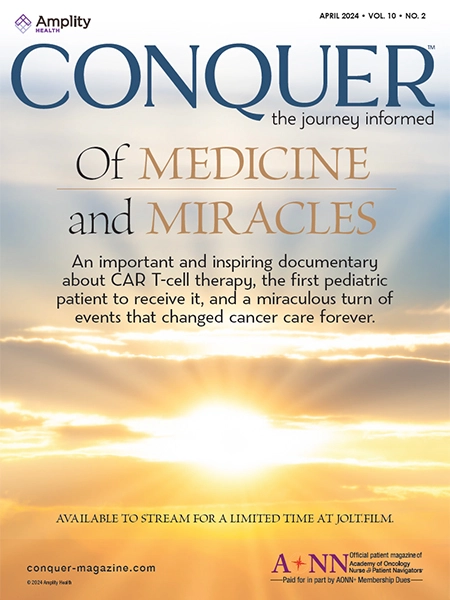Overview of CML
Chronic myelogenous leukemia (CML) is a myeloproliferative disorder that originates in the bone marrow. It accounts for 15% of all leukemias affecting adults, and the median age of disease onset is 67 years.1 By the end of 2015, an estimated 6660 individuals will have been diagnosed with CML in the United States, and approximately 1140 individuals will have died from the disease.2 Although primarily a disease of older adults, CML may also affect younger populations or children.3,4
There are no known risk factors for CML, although exposure to ionizing radiation has been implicated, as evidenced by the increased prevalence of the disease among survivors of the atomic bombings of Hiroshima and Nagasaki; benzene is another possible culprit.3 In recent years, the prognosis for patients with CML has improved dramatically, due to the development of new targeted therapies. Currently, the median survival is ≥5 years, with a 5-year survival rate of 50% to 60% following treatment.3,4 An important prognostic factor in CML is the patient’s response to therapy.4,5
CML is a clonal myeloproliferative hematopoietic stem-cell disorder and is unique in that it is characterized by the presence of a single chromosome known as the Philadelphia (Ph) chromosome. The Ph chromosome results from the reciprocal translocation of the breakpoint cluster region (BCR) on chromosome 22 and the Abelson gene (ABL) on chromosome 9 (Figure 1).6-8 The BCR-ABL gene causes an increase in tyrosine kinase protein, which leads to increased cell proliferation of blood cells, impaired adhesion, and inhibition of apoptosis.4,6 A triphasic disorder, CML consists of a chronic phase, an accelerated phase, and a blast phase. More than 90% of patients present in the chronic phase at diagnosis.6
Since CML is a chronic disorder that requires lifelong therapy, it is very important for oncology nurse navigators (ONNs) to familiarize themselves with the pathophysiology of the disease and effective management strategies. The ONN plays a crucial role in supporting patients who are on oral therapy by helping to ensure adherence, which directly correlates with the patient’s response to treatment.6,9,10 Typically, nurses and ONNs are the healthcare professionals who educate patients and their families on CML, which empowers patients to become active participants in their own care.
Diagnostic Testing in CML
Patients who present with CML in the chronic phase are usually asymptomatic. As a result, they may be diagnosed with the disease incidentally from routine peripheral blood studies or annual wellness examinations.6 In the chronic phase of CML, signs, symptoms, and physical examination findings may include fatigue, weight loss, decreased exercise tolerance, early satiety, left upper quadrant pain, hepatomegaly, splenomegaly, and an elevated white blood cell (WBC) count.3 Signs and symptoms of more advanced disease (ie, accelerated or blast phase) are bleeding, bone pain, fever, and anemia.3,7 On peripheral blood smear, an elevated WBC count combined with basophilia, eosinophilia, anemia, thrombocytosis, or thrombocytopenia would prompt diagnostic testing for CML. Myeloid blast cells, such as myeloblasts, myelocytes, metamyelocytes, or nucleated red blood cells (RBCs), may also be seen on examination of peripheral blood.3,6
The diagnostic workup for CML includes testing for the hallmark Ph chromosome or BCR-ABL gene. The gene is identified through testing on peripheral blood as well as by bone marrow aspirate and biopsy.3,6 There are 3 diagnostic methods available to detect the BCR-ABL gene: (1) conventional karyotype analysis, which is performed on bone marrow aspirates; (2) quantitative reverse transcriptase polymerase chain reaction (qRT-PCR); and (3) fluorescence in situ hybridization (FISH). The most sensitive method for detecting the BCR-ABL gene is by qRT-PCR. This molecular test is capable of detecting the BCR-ABL gene in 1 cell out of 1 million normal cells.6 An international scale has been developed to provide consistency in testing and reporting standards among laboratories.11,12
While diagnostic testing for CML is under way, the role of the ONN on behalf of the patient is to coordinate physical examinations and reinforce patient education regarding test results and their corresponding implications. Once a diagnosis of CML has been made, the nurse navigator is a very effective point person in providing disease-specific educational materials, details about the use of lifetime oral therapy, and assistance in accessing medication through specialty pharmacies, patient assistance programs, or insurance prior authorizations.6
Treatment Considerations in CML
A patient’s response to treatment may be measured by complete hematologic response, complete cytogenetic response (CCyR), and major molecular response.1,5,7 Hematologic response is defined as normalization of the patient’s complete blood count (CBC) levels, cytogenetic response is measured by collecting a FISH panel, and molecular response is measured with the qRT-PCR test. Studies have shown that there is excellent correlation between blood and marrow FISH results, which eliminates the need for frequent bone marrow examinations after the initial diagnosis of CML has been established.13 Standardized monitoring response guidelines have been established by the National Comprehensive Cancer Network (NCCN) and European LeukemiaNet, which provide time points when patients should be tested for response following initiation of therapy.1,5 Once therapy is initiated, patients should be monitored for response after 3, 6, and 12 months.1,5 If they achieve and maintain a remission, it is recommended that they be monitored for molecular response every 3 months for the first 2 years of treatment, and every 3 to 6 months thereafter. Hematologic response is defined as normalization of the CBC, and the goal for response is 3 months after initiation of therapy. An optimal cytogenetic response is defined as partial cytogenetic response at 3 months and CCyR at 12 months and beyond during treatment. Optimal molecular response is defined as BCR-ABL transcript levels of ≤10% at 3 months postinitiation of therapy, <1% at 6 months, and ≤0.1% at 12 months and onward. The patient’s best prognostic factor is their response to treatment.1,5
In recent years, treatment for CML has been revolutionized by the development of targeted therapy with tyrosine kinase inhibitors (TKIs). In the past, the treatment of choice for patients with CML was hematopoietic stem-cell transplantation (HSCT); however, with the development of targeted therapy with TKIs, transplant is reserved for patients with advanced disease, or those not responding to therapy.1,3-5,7 There are currently 5 TKIs approved by the US Food and Drug Administration for the treatment of CML. Each of these agents may be used for treatment of chronic-phase CML, and several may also be used for the treatment of accelerated- or blast-phase CML. If a patient presents with a high WBC count at diagnosis, they are at risk for thrombotic events, so leukapheresis or cytoreductive therapy is often used prior to the start of therapy with TKIs.4 Patients in advanced phases (ie, accelerated or blast phase) or patients who have not responded to 2 or more TKIs should be considered for an HSCT.1,3-5,7
ONNs are the main point of contact between patients with CML and their treating physicians. They can empower patients by providing them with education about their diagnosis, the agents that they are treated with, and the expectations for response to therapy. Having reliable patient education materials on hand is very important, particularly in a culture where information is easily accessed electronically. When the patient starts a new TKI, it is imperative to educate him or her about common side effects, as well as warning signs of adverse reactions. Unlike patients with other types of leukemia, patients with CML are not normally situated in a hospital setting under the close watch of a medical team. Therefore, these patients and their family members need to be educated as to when to notify the physician’s office to report treatment-related toxicities. ONNs may help patients avoid delays in therapy by obtaining insurance approval and coordinating delivery of prescribed medications through specialty pharmacies. Nurse navigators also play an important role in ensuring that patients’ appointments with their physicians and periodic molecular monitoring tests are scheduled at appropriate times, and in following up with patients to provide test results and explain their significance as it relates to treatment response.6
Survivorship Issues in CML
As a result of recent advances in the treatment of CML, most patients are now living at least 5 years after being diagnosed with the disease.3,4 Those who achieve molecular remission are considered to have responded to treatment, but at this point the recommendation is to continue lifelong treatment with a TKI.5,6 This may have a great economic impact on the patient since the cost of therapy may be very high.5 If the patient is younger and still in childbearing years, it poses questions and issues regarding the decision to procreate. Since TKIs have not been tested in pregnant women, their use during conception or pregnancy is not recommended. Patients with CML are also subject to lifelong follow-up to monitor for recurrence of disease. If it is determined that a patient should undergo HSCT, he or she will require lifelong follow-up to monitor for graft-versus-host disease.
Overview of AML
Acute myelogenous leukemia (AML) is a myeloid disorder that originates in the bone marrow. It is a rare disease that affects older adults and is more common among men than women. AML is most frequently diagnosed in individuals aged 75 to 84 years, and the median age at diagnosis is 67 years.14 Cancer statistics from the US Surveillance, Epidemiology, and End Results program indicate that an estimated 20,830 new cases of AML will be diagnosed through 2015, and an estimated 10,460 people will die of the disease.14 Between 2005 and 2011, the 5-year survival rate for patients with AML was 25.9%, compared with the survival of patients in the general population in the same age range who have not been diagnosed with cancer (Figure 2).14 Factors that may affect prognosis include age, cytogenetics, a history of a blood disorder (eg, myelodysplastic syndrome [MDS]), the existence of prior cancers, and adjunct chemotherapy. Risk factors for AML include exposure to cytotoxic chemotherapy treatment for other cancers, radiation therapy, smoking, and antecedent hematologic conditions such as MDS or myeloproliferative disorders.15
Typically, a normal healthy bone marrow produces blood stem cells that become mature myeloid or lymphoid stem cells over time. The myeloid stem cell becomes a mature RBC, WBC, or platelet. RBCs carry oxygen to other parts of the body, WBCs fight infection and disease, and platelets form blood clots to stop bleeding. However, in AML, the myeloid stem cells frequently become immature WBCs called myeloblasts. These cells are abnormal and never mature into healthy WBCs. Additionally, a large number of other stem cells may become abnormal RBCs or platelets. All of these can build up in the bone marrow and bloodstream, preventing normal, healthy cells from growing. This excess amount of immature unhealthy cells leads to infection, anemia, and bleeding. Leukemia cells may also spread to other parts of the body, such as the central nervous system, skin, and gums.15
AML is a very serious disease that may rapidly become fatal if not treated in a timely manner. It is very important for the ONN to be aware of the pathology of the disease, as well as early signs and symptoms. Patients with AML should be evaluated and treated in a tertiary center with appropriate resources and training. Because of the increased risk for infection and bleeding, patients require support with prophylactic antibiotics and infusion of blood products.16 AML is unique in that it is an acute condition that develops rapidly, and patients may become very ill in a short period of time. Therefore, it is imperative that ONNs understand the importance of acting quickly to provide support to patients and their family members.
Diagnostic Testing in AML
The signs and symptoms of AML are related to the immature production and dysfunction of the blood cells in the bone marrow. Patients are likely to experience fever, shortness of breath, easy bruising, bleeding, fatigue, weight loss, or petechiae—which are pinpoint spots under the skin caused by bleeding.15 A thorough physical examination and history is part of the diagnostic workup for the disease. Diagnostic testing for AML includes laboratory studies such as a CBC; chemistry studies of prothrombin time, partial thromboplastin time, and fibrinogen; and a peripheral blood smear to look for blast cells, the number and types of WBCs, the number of platelets, and changes in the appearance of blood cells. Bone marrow aspiration and biopsy provide samples used to obtain information about the type of AML, as well as specific factors that may affect prognosis.15 According to the French–American–British classification system for AML (the original standard), a blast percentage of 30% in the bone marrow was the indicator used to formulate a diagnosis of AML. The World Health Organization later lowered this threshold to a blast percentage of 20% or more in the bone marrow.16,17
Cytogenetic, molecular, and immunophenotyping studies provide information about the patient’s chances of responding to treatment as well as the likelihood of relapse after treatment is completed. Information derived from cytogenetic studies guide long-term treatment decisions related to the type of chemotherapy agents used and whether an HSCT is warranted.16,17 Cytogenetic studies are used to detect changes in chromosomes and immunophenotyping analyzes the type of antigens or markers on the surface of the cells, which is used to determine the subtype of AML.15 Human leukocyte antigen typing of the patient should be ordered so that testing of sibling and unrelated donors may be performed if a stem-cell transplant is warranted.16 If a patient exhibits neurologic symptoms, a computed tomography scan or magnetic resonance imaging should be done to evaluate for a mass. If no mass is found on imaging studies, a lumbar puncture (LP) should be performed. Additionally, if a patient presents with a WBC count >40,000/μL at diagnosis, an LP should be performed as part of the screening process to evaluate for meningeal disease.16 In patients with a history or symptoms of cardiac disease or prior exposure to cardiotoxic drugs or thoracic radiation, an echocardiogram or multigated acquisition scan should be performed to evaluate cardiac health and a central venous catheter (CVC) is needed to administer chemotherapy.16
The diagnostic and screening process may be very overwhelming for patients, particularly since AML follows an acute process. The ONN is extremely vital to patients and their caregivers during this initial period of the process. Providing pertinent education about diagnostic procedures, results of the examinations, and what to expect during upcoming treatment may help to reduce anxiety. The ONN may also assist patients admitted to the hospital for urgent care in locating transportation and childcare. They can also help patients communicate effectively with their employers.
Treatment Considerations in AML
The goals of treatment for patients with AML are to induce remission of the disease and to maintain that remission. Treatment for the disease consists of an induction phase and consolidation phase; overall, maintenance treatment has not been found to be effective.16,17 The method of treatment for AML has remained relatively unchanged over the past few decades, but is evolving to accommodate patients from an older age-group and those with a history of other types of cancer.18 Induction therapy consists of a regimen using 2 different agents and is given as a continuous infusion over a period of 7 days. It consists of an anthracycline and antimetabolite, and adjustments may be made for age or cardiac toxicity.16-18 A patient’s response to induction therapy is very important and will predict future treatments. A bone marrow biopsy will be taken within 2 weeks of the start of induction treatment and again 1 month later, to assess for response/remission of the disease.16 The NCCN provides guidelines about treatment options if the patient does not respond to the initial induction treatment.16
Consolidation therapy begins immediately following count recovery after induction once the patient is in remission, and is given for 3 to 4 monthly cycles. Based on the patient’s risk category, they may or may not be candidates for stem-cell transplant, preferably from a fully matched sibling—but if there is none available, a favorable match may be found from the National Marrow Donor Program. Hypomethylating agents are used in patients who are unable to tolerate the intensive induction regimen; there are 2 drugs in this category and they are given once every 3 to 4 weeks for 5 to 7 days consecutively and may be administered in the outpatient setting.16,17
Throughout the course of treatment, patients with AML need supportive care with blood product transfusions and prophylactic antibiotics.16 Low counts of RBCs and platelets are caused by the treatment of the leukemia, as well as the leukemia itself. Patients with AML require irradiated and leukocyte-depleted blood products. NCCN guidelines also recommend transfusing RBCs for a hemoglobin level ≤8 g/dL or for symptomatic anemia, and platelet transfusion is recommended in patients with platelets <10,000/mcL or with any signs of bleeding.16 During initial induction treatment, patients need to be monitored closely and treated for tumor lysis syndrome, particularly if they present at diagnosis with a high WBC count or high blast percentage.
Low WBC count or neutropenia may be caused by chemotherapy or by the leukemia itself. Patients should remain on prophylactic antibiotics during the neutropenic stages of induction and consolidation treatments; coverage should ideally include an antiviral, antibiotic, and an antifungal. Patients who remain neutropenic for long periods of time are more vulnerable to aggressive infections, particularly fungal infections.16 Growth factors may be used in the postremission period, but should be stopped 7 days prior to any bone marrow biopsy as they may cause the results to be misinterpreted.16 General infection precautions to follow when coming into contact with patients with AML include handwashing, avoiding contact with individuals or other patients who may have a contagious illness, and avoiding the consumption of raw meats.19
ONNs have many responsibilities while patients are undergoing therapy. They coordinate appointments for treatment, whether they take place in the hospital or outpatient setting, and arrange home care support as necessary for care of CVCs or administration of intravenous antibiotics. They also coordinate appointments for supportive-care treatments (eg, blood product transfusions), provide education on chemotherapy regimens, ensure that patients are taking prescribed medications correctly, and provide emotional and psychological support throughout the course of therapy and beyond. Support from other team members (eg, social worker, nutritionist, palliative care specialist, chaplain) may be beneficial to patients and their families during this time, and the nurse navigator may make helpful recommendations in this regard.
If treatment is being administered in the outpatient setting and the patient does not live close to the treatment center, transportation and housing will most likely become a consideration. In addition, patients and their caregivers may need to be taught how to care for CVCs at home, and how to locate the necessary supplies for dressing changes, line flushes, etc.
Survivorship Issues in AML
Between 2005 and 2011, the 5-year survival rate for AML was 25.9%.14 Upon completion of consolidation therapy, the patient should be monitored for relapse or recurrence of AML with a CBC every 1 to 3 months for 2 years and then every 3 to 6 months for up to 5 years. A bone marrow biopsy is not conducted unless there are abnormal findings on the peripheral blood smear or changes in the blood count. In the case of relapse or recurrence of disease, the patient needs to be immediately started on treatment to induce a remission, and a donor search should begin for a stem-cell transplant.16 In certain instances, if the patient is considered to be at high risk for relapse, they will receive a transplant in the first remission. Factors that increase this risk include poor-prognosis cytogenetics, therapy-related AML (caused by earlier treatment of another cancer), prior MDS, or the need for 2 or more inductions to achieve the first remission.16 During the monitoring phase following remission, patients may experience a great deal of anxiety about the possibility of relapse, particularly when they come in for physician and laboratory appointments. Attention should be given to ongoing medical issues (diabetes, hypertension, high cholesterol, etc) and the patient may be referred back to their primary care physician for management of these conditions. Patients who are not responding to treatment should be appropriately referred to hospice care either in an inpatient or home care setting.
Conclusions
For patients with CML or AML, having the support of an ONN who is educated and knowledgeable about the pathology and treatment of these diseases is extremely important. Navigating the complex diagnostic workup, treatment phase, and chronic monitoring procedures is difficult for a patient if they do not have the support of a qualified healthcare professional to guide them through the process. Open communication and easy accessibility of the ONN through phone, e-mail, or electronic portal methods may alleviate some of the concerns that patients and their caregivers may have. Just as important is the coordination among all members of the healthcare team, which ultimately improves patient care.
References
- National Comprehensive Cancer Network. NCCN Clinical Practice Guidelines in Oncology®: Chronic Myelogenous Leukemia. Version 1.2016. www.nccn.org/professionals/physician_gls/pdf/cml.pdf. Accessed September 20, 2015.
- Siegel RL, Miller KD, Jemal A. Cancer statistics, 2015. CA Cancer J Clin. 2015;65:5-29.
- Besa E. Chronic myelogenous leukemia: practice essentials, background, pathophysiology. emedicine.medscape.com/article/199425-overview. Accessed July 29, 2015.
- Sawyers CL. Chronic myeloid leukemia. N Engl J Med. 1999;340:1330-1340.
- Baccarani M, Deininger MW, Rosti G, et al. European LeukemiaNet recommendations for the management of chronic myeloid leukemia: 2013. Blood. 2013;122:872-884.
- Holloway S, Lord K, Bethelmie-Bryan B, et al. Managing chronic myeloid leukemia: a coordinated team care perspective. Clin Lymphoma Myeloma Leuk. 2012;12:88-93.
- National Cancer Institute. Chronic myelogenous leukemia treatment–for healthcare professionals (PDQ®). www.cancer.gov/cancertopics/pdq/treatment/CML/healthprofessional/allpages. Accessed September 10, 2015.
- Kantarjian H, Shah NP, Hochhaus A, et al. Dasatinib versus imatinib in newly diagnosed chronic-phase chronic myeloid leukemia. N Engl J Med. 2010;362:2260-2270.
- Marin D, Bazeos A, Mahon FX, et al. Adherence is the critical factor for achieving molecular responses in patients with chronic myeloid leukemia who achieve complete cytogenetic responses on imatinib. J Clin Oncol. 2010; 28:2381-2388.
- Ibrahim AR, Eliasson L, Apperley JF, et al. Poor adherence is the main reason for loss of CCyR and imatinib failure for chronic myeloid leukemia patients on long-term therapy. Blood. 2011;117:3733-3736.
- Radich JP. How I monitor residual disease in chronic myeloid leukemia. Blood. 2009;114:3376-3381.
- Hughes T, Deininger M, Hochhaus A, et al. Monitoring CML patients responding to treatment with tyrosine kinase inhibitors: review and recommendations for harmonizing current methodology for detecting BCR-ABL transcripts and kinase domain mutations and for expressing results. Blood. 2006;108:28-37.
- Lima L, Bernal-Mizrachi L, Saxe D, et al. Peripheral blood monitoring of chronic myeloid leukemia during treatment with imatinib, second-line agents, and beyond. Cancer. 2011;117:1245-1252.
- National Cancer Institute. SEER Stat Fact Sheets: Acute Myeloid Leukemia (AML). http://seer.cancer.gov/statfacts/html/amyl.html#incidencemortality. Accessed September 17, 2015.
- National Cancer Institute. Adult Acute Myeloid Leukemia Treatment (PDQ®). www.cancer.gov/cancertopics/pdq/treatment/adultAML/patient. Accessed September 17, 2015.
- National Comprehensive Cancer Network. NCCN Clinical Practice Guidelines in Oncology®: Acute Myeloid Leukemia. Version 1.2015. www.nccn.org/professionals/physician_gls/pdf/aml.pdf. Accessed September 20, 2015.
- El Rassi F, Arellano M. Update on optimal management of acute myeloid leukemia. Clin Med Insights Oncol. 2013;7:181-197.
- Rowe JM, Tallman MS. How I treat acute myeloid leukemia. Blood. 2010;116:3147-3156.
- National Comprehensive Cancer Network. NCCN Clinical Practice Guidelines in Oncology®: Prevention and Treatment of Cancer-Related Infections. Version 2.2015. www.nccn.org/professionals/physician_gls/pdf/infections.pdf. Accessed September 21, 2015.















